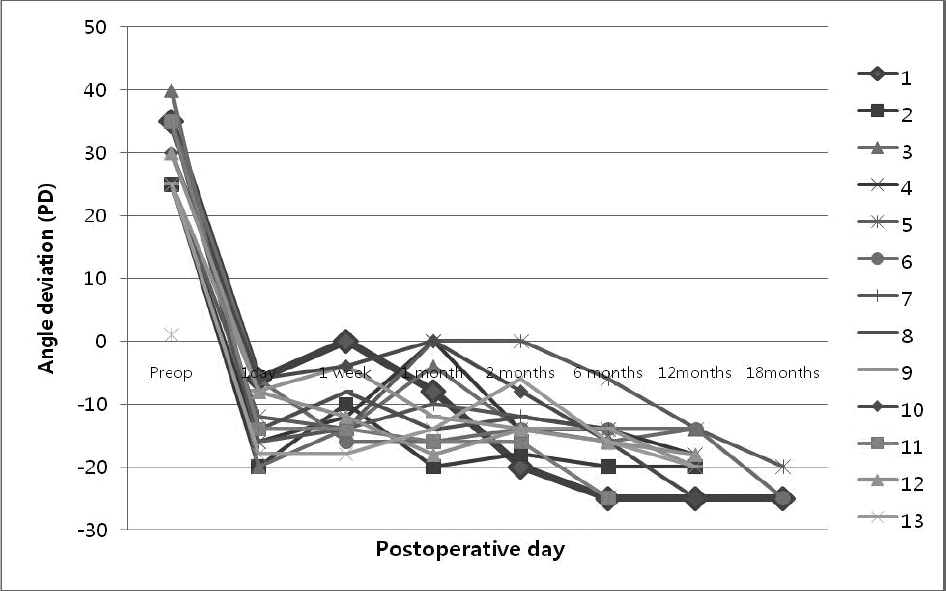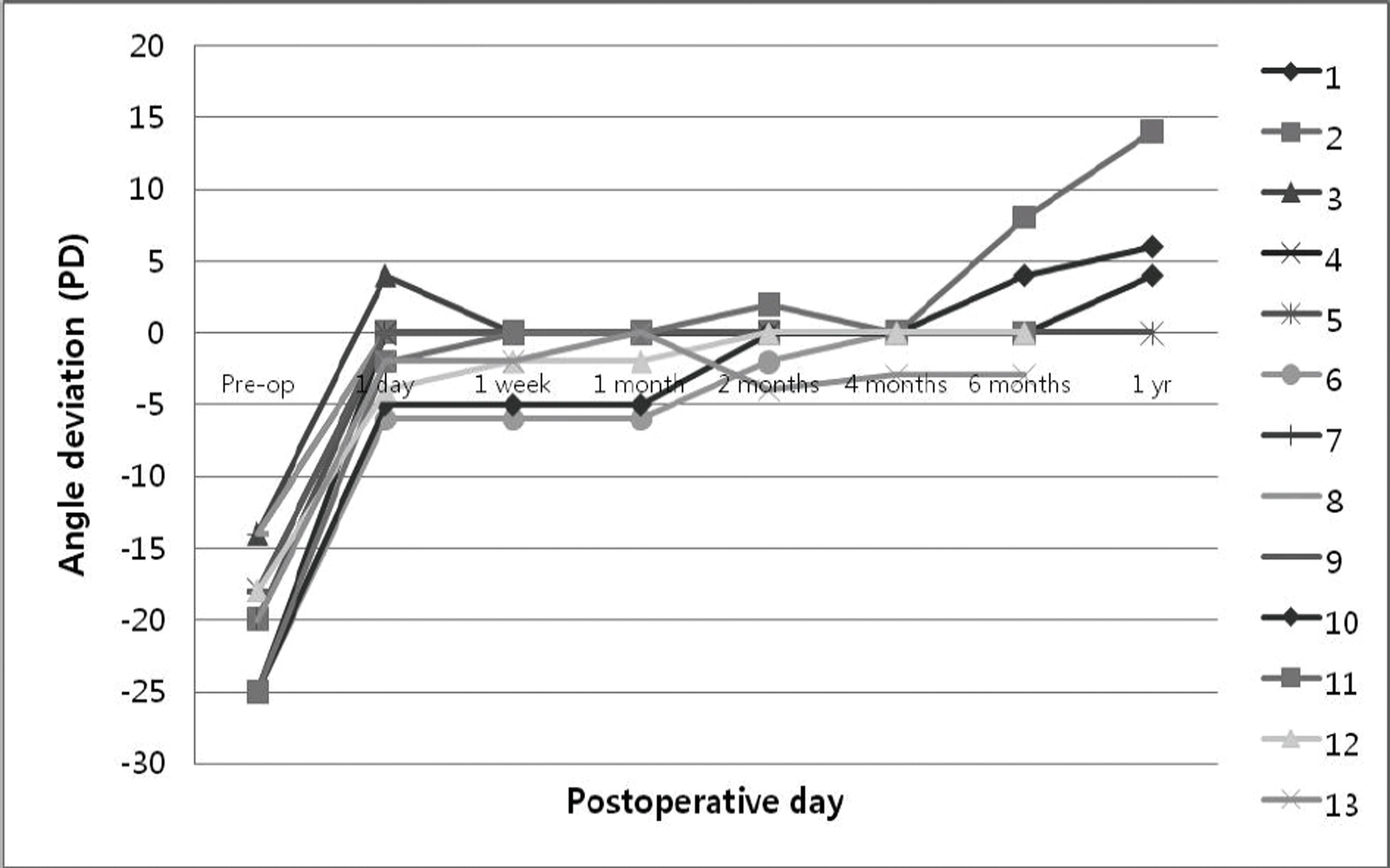Abstract
Purpose
To investigate the clinical outcomes of unilateral lateral rectus muscle advancement in patients with consecutive esotropia after bilateral lateral rectus muscle recession.
Methods
We investigated the results of 13 patients who underwent unilateral lateral rectus muscle advancement for consecutive esotropia after bilateral lateral rectus muscle recession. We evaluated the amount of deviation, changes of angle deviation, corrected amount/mm, and sensory status after each surgery.
Results
The average angle deviation of exotropia was 30.42±5.41PD, and the average amount of bilateral lateral rectus muscle recession was 6.73±0.59 mm. The average angle deviation of esotropia one day after the surgery was 13.17±5.15PD. Occlusion treatment was performed during follow-up. The surgery for consecutive esotropia was performed after an average of 12.0±7.25 months of follow-up. In Worth-4-dot tests, 12 patients showed diplopia, and 1 patient showed suppression after the surgery for exotropia. Nine patients showed diplopia, and 4 patients showed suppression just before the surgery for consecutive esotropia. One patient showed mild limitation of motion of the lateral rectus muscle (-1 degree). The average angle deviation before the surgery for consecutive esotropia was 19.42±4.20PD. An average of 6.73±0.79 mm of unilateral lateral rectus muscle advancement was performed. After surgery, the average angle deviation was 1.25±2.73PD esodeviation, and 1.42±4.44PD exodeviation after 6 months. In Worth-4-dot tests, 6 patients showed fusion, 2 patients showed diplopia, and 5 patients showed suppression after surgery for consecutive esotropia.
Go to : 
References
1. Raab EL, Parks MM. Recession of the lateral recti. Early and late postoperative alignments. Arch Ophthalmol. 1969; 82:203–8.

2. Scott WE, Keech R, March AJ. The postoperative results and stability of exodeviations. Arch Ophthalmol. 1981; 99:1814–8.

3. Souza-Dias C, Uesugui CF. Postoperative evolution of the planned initial overcorrection in intermittent exotropia: 61 cases. Binocular Vis Eye Muscle Surg Q. 1993; 8:141–8.
4. Paik HJ, Cho YA. Recession of the Lateral Recti in Intermittent Exotropia Evaluation of the Amount of Immediate Postoperative deviation. J Korean Ophthalmol Soc. 1990; 31:1445–50.
5. Lee SY, Lee YC. Comparison of Surgical Results by Initial Postoperative Alignment Following Bilateral Lateral Rectus Recession and Unilateral Lateral Rectus Recession-Medial Rectus Resection in Intermittent Exotropes. J Korean Ophthalmol Soc. 1999; 40:2604–10.
6. Fletcher MC, Silverman SJ. Strabismus parts, A summary of 1110 consecutive cases. Am J Ophthalmol. 1966; 61:86–94.
7. Von Noorden GK. Divergence excess and simulated divergence excess: diagnosis and surgical management. Doc Ophthalmol. 1969; 26:719–28.

8. Hardesty HH, Boynton JR, Keenan JP. Treatment of intermittent exotropia. Arch Ophthalmol. 1978; 96:268–74.

9. Cho YA, Kang SM, Roh GH. Asymmetric Bilateral Lateral Recti Recession in Intermittent Exotropia. J Korean Ophthalmol Soc. 1999; 40:544–9.
10. Shin YJ, Chang BL. The clinical outcome of the consecutive esotropia after surgical correction. J Korean Ophthalmol Soc. 2003; 44:2085–90.
12. Kim JH, Hwang JM. Initial overcorrection of 20Δ or more after surgery of exotropia. J Korean Ophthalmol Soc. 2003; 44:121–7.
13. Kim YH, Choi MY. The effect of Fresnel Prism Treatment in Consecutive Esotropia. J Korean Ophthalmol Soc. 2006; 47:1623–9.
14. Wilson ME. “Tying the Knot”– Surgical choices in Esotropia: When? How Much? How many? Am Orthopt J. 1996; 46:65–72.
15. Helveston EM. Surgical management of strabismus. An atlas of strabismus surgery, 4th ed. St. Louise: The C.V. Mosby company;1993; 284:448.
16. Kim JS, Son KH. The Effect of Advancement of the Lateral Rectus Muscle on the Consecutive Esotropia. J Korean Ophthalmol Soc. 1995; 36:1784–9.
17. Roh YB, Lee JR. Consecutive Esotropia after Surgery for Intermittent Exotropia. J Korean Ophthalmol Soc. 1998; 39:388–92.
Go to : 
Table 1.
Patients’ data
| Exotropia angle deviation (PD) | BLR rec.*(mm) | POD #1† angle deviation (PD) | Consecutive esotropia angle eviation (PD) | Unilateral LR Adv.‡(mm) | POD #1† angle deviation (PD) | Angle deviation after 6 months (PD) | Corrected PD per Adv.‡(mm) after consecutive esotropia surgery (PD/mm) | |
|---|---|---|---|---|---|---|---|---|
| 1 | 35 | 7.0 | -6 | -25 | RLR 3.0 | 0 | 6 | |
| 2 | 25 | 6.5 | -20 | -20 | LLR 6.5 | 0 | 14 | 3.08 |
| 3 | 40 | 8.0 | -20 | -14 | LLR 7.0 | 4 | 0 | 2.57 |
| 4 | 25 | 6.0 | -16 | -18 | LLR 6.0 | 0 | 0 | 3.00 |
| 5 | 25 | 6.0 | -12 | -20 | LLR 6.0 | 0 | 0 | 3.33 |
| 6 | 35 | 7.0 | -6 | -25 | LLR 8.0 | -6 | 0 | 2.38 |
| 7 | 35 | 7.0 | -16 | -14 | LLR 6.0 | 0 | 0 | 2.33 |
| 8 | 35 | 7.0 | -14 | -14 | LLR 6.0 | 0 | 0 | 2.33 |
| 9 | 25 | 6.5 | -8 | -20 | RLR 6.5 | 0 | 0 | 2.77 |
| 10 | 30 | 6.5 | -6 | -25 | RLR 7.5 | -5 | 6 | 2.67 |
| 11 | 35 | 7.2 | -14 | -25 | LLR 8.2 | -2 | 0 | 2.80 |
| 12 | 30 | 7.0 | -8 | -18 | LLR 6.5 | -4 | 0 | 2.15 |
| 13 | 25 | 6.0 | -18 | -20 | RLR 6.5 | -2 | -3 | 2.77 |
| Mean | 30.42 | 6.73 | -13.17 | -19.42 | LR 6.73 | -1.25 | +1.42 | 2.68 |




 PDF
PDF ePub
ePub Citation
Citation Print
Print




 XML Download
XML Download